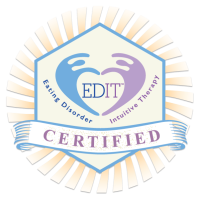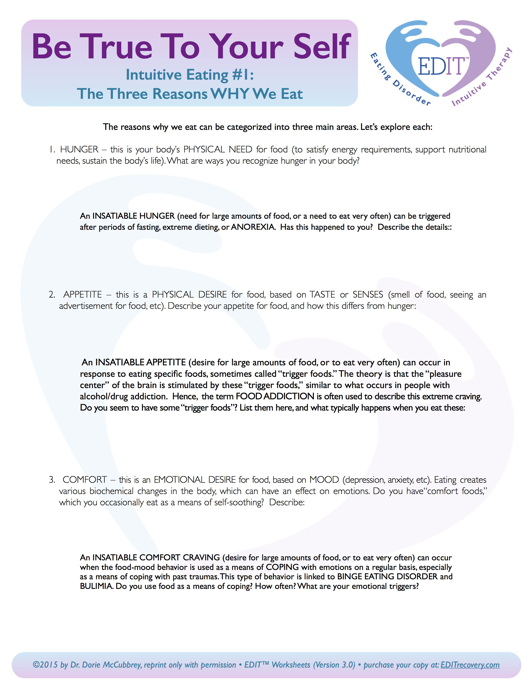EDIT™ Principle #2 – Be True To Your Self
The second EDIT™ Principle involves everything about INTUITION – how to use one’s intuitive wisdom for guidance about eating, exercise, and everyday life. This intuitive wisdom is what we can also call the insight of the Intuitive Therapist within us all. People with eating disorders typically only hear the chatter of their eating disorder (ED) mind. But as EDIT™ Practitioners, we model the voice of the Intuitive Therapist (IT) until clients can her IT within themselves. The EDIT™ process involves having ED-IT dialogues with clients. Here’s what this might sound like:
ED (false self) – “I follow the rules and do what I should do.”
The “rules” involve eating, exercising, and other eating disorder behaviors, as well as countless expectations of others. The false self adopts these rules as ones own, unaware that they are being imposed from outside influences. Many rules contradict each other, which is a setup for the rules to be broken, followed by attempts to resume the rules with even more rigidity. The false self is adamant that it is moving in the right direction, without realizing it is blindly going in circles.
IT (True Self): “I trust my intuition, in all areas of my life.”
Intuition is an inner knowing, a gut feeling, an awareness which comes without any logical analysis – it is the “voice” of the True Self. Intuition is accessed to guide all decisions, including career direction, family and relationship choices, as well as eating and exercise selections. The True Self may listen to the others opinions, then discern whether they are in alignment with ones own values. The True Self has an inner compass, which always points in the right direction.
Try this “taste” of EDIT™ – Reasons WHY We Eat
Click on the image below for a downloadable worksheet which you can use to explore how the concepts of intuition can be applied to eating disorder behaviors. Discuss the three reasons WHY we eat, and guide your client to trust their INTUITION for the type and amount of food their body needs.
Scroll below the image for guidelines about using the worksheet.
CLICK ON IMAGE TO DOWNLOAD AND PRINT
I’m feeling low on energy, and need a snack…
I just finished dinner, and want something sweet…
I’ve just had a stressful day, and want my favorite comfort food…
Can you relate to eating for these three different reasons? The first is the body’s PHYSICAL NEED for food – or, HUNGER. The second is a PHYSICAL DESIRE for specific foods although not necessarily hungry, for example, dessert – also called APPETITE. The third is an EMOTIONAL DESIRE for specific foods, as a means of self-soothing – referred to as COMFORT. It’s normal to eat for all three of these reasons – and eating disorders reflect being out of balance with why we eat. Eating disorder recovery is about restoring this balance, through Intuitive Eating.
As a little more background information for you as an EDIT™ practitioner – I developed the terminology for these three reasons why people eat as an outcome of my own research. I observed the eating patterns of people who reported never having had an eating disorder, and noted that the reasons people ate fell into three main categories. My original terms were “Physical Need,” “Physical Desire,” and “Emotional Desire” – which I have since simplified as “Hunger,” “Appetite,” and “Comfort.”
On a typical day, people without eating disorders reported eating for the three different reasons with these percentages: Hunger (75-100%), Appetite (0-25%), Comfort (0-10%). What this means is that some days, a person might eat in this distribution: Hunger (75%), Appetite (15%), Comfort (10%). Another day, perhaps their proportions may be: Hunger (90%), Appetite (10%), Comfort (0%). Occasionally, people without eating disorders reported: Hunger (100%), Appetite (0%), Comfort (0%). However, most often, people without eating disorders ate with some percentage for all three reasons.
When I ask people with eating disorders the reasons why they eat, I often find different ranges for different types of eating disorders. For example, people with Anorexia typically report something like: Hunger (100%), Appetite (0%), Comfort (0%). However, many anorexics resist eating even if they do feel hungry, and only eat if they feel extreme hunger. In contrast, people with Bulimia or Binge Eating Disorder typically report something like: Hunger (0%), Appetite (25%), Comfort (75%). These individuals may actually eat some of the time because they are hungry – but to them it might seem like they are eating because they “want to” but don’t really “need to.” These individuals especially identify with eating for comfort, noting that they use food as a means of coping with intense emotions. People who identify themselves as having a Food Addiction report a slightly different percentage, usually something like: Hunger (0%), Appetite (75%), Comfort (25%). These individuals tend to relate to the concept that they are drawn to the taste of food and “love to eat,” but are less aware of using food as a means of emotional coping.
When you use this worksheet with your clients, begin by explaining the three reasons why people eat. Next, ask your client why they tend to eat on a typical day, so you can get a sense of their percentages for each of the three reasons. Ask your client why they think they “should” eat – any they will probably say something like, “I should only eat when I’m hungry” – which is what many weight loss programs advocate. Emphasize that it’s OK to eat for all three reasons, and then encourage your client to being their journey of Intuitive Eating by simply noticing their current eating patterns. Encourage them to gently ask, “Why am I about to eat right now?” Non-judgmental awareness is the first step in eating disorder recovery!
©2018 by Dr. Dorie McCubbrey. Dr. Dorie is a Certified Eating Disorder Specialist and Licensed Addiction Counselor who is passionate about training professionals to effectively guide clients in recovery from eating disorders, through her Eating Disorder Intuitive Therapy (EDIT)™ Certified program. She also meets with clients at her treatment center, Positive Pathways PLLC, located in Evergreen Colorado. Learn more at: https://www.editcertified.com
Article may be reprinted with this author bio.
*****
Want more that this “taste” of EDIT™? Dr. Dorie is passionate about her method of Eating Disorder Intuitive Therapy (EDIT)™ to help people overcome eating disorders and addictions. She provides customized counseling for eating disorders and alcohol / drug addiction at her Positive Pathways treatment center in Evergreen, Colorado – and EDIT™ eating disorder training and certification for coaches and clinicians worldwide. CALL 303-494-1975 – EMAIL DR. DORIE – GET CERTIFIED


